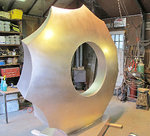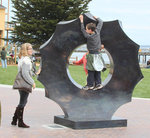Don’t compare it to the Tidal Clock, Port Townsend’s painful waterfront failure with public art.
The “Salish Sea Circle” is something entirely new and different.
At least, that’s what …
This item is available in full to subscribers.
We have recently launched a new and improved website. To continue reading, you will need to either log into your subscriber account, or purchase a new subscription.
If you had an active account on our previous website, then you have an account here. Simply reset your password to regain access to your account.
If you did not have an account on our previous website, but are a current print subscriber, click here to set up your website account.
Otherwise, click here to view your options for subscribing.
* Having trouble? Call our circulation department at 360-385-2900, or email our support.
Please log in to continue |
|


Don’t compare it to the Tidal Clock, Port Townsend’s painful waterfront failure with public art.
The “Salish Sea Circle” is something entirely new and different.
At least, that’s what almost everyone who knows the whole “Tidy Bowl” story hopes will come true.
See for yourself once the public art is unveiled on Saturday at 1 p.m. at the Civic District ceremony, taking place at the corner of Madison and Water streets, across from City Hall.
The event marks the third week of a Port Townsend Civic District dedication. Expect downtown to be bustling with the 33rd Rhody Arts and Crafts Fair on Madison Street, from 10 a.m. to 6 p.m. on Saturday and Sunday. It’s the first craft fair since Madison Street sidewalks were changed.
The sculpture dedication is at 1 p.m. A variety of children’s art activities take place in the Pope Marine Building from 2 to 4 p.m. as part of Main Street’s Art Wave program, which displays children’s art in all the stores through May.
‘Salish Sea Circle’
Celebrated Seattle artist Gerard Tsutakawa wants people to touch and even climb (at least through the 3-foot hole) his 800-pound, 8-foot-tall, 7-foot-wide silicon-bronze work.
Around the outside of the sculpture are nine asymmetrical “waves.” The piece represents the “continuum and revitalization of Port Townsend from its early days to days to come,” the artist said.
Tsutakawa envisioned his work placed at Pope Marine Park’s Madison and Water street corner, and that’s where it is. Artistic vision alone was not enough in the selection process; the artwork’s durability in the notoriously wet and blustery waterfront conditions was vital.
"There is a sense of dynamic energy in the undulating curves of the sculpture that captures a lot about what makes Port Townsend unique and what ties it to the rich maritime fabric of the region," said Kris Morris, Port Townsend Arts Commission (PTAC) member. "Although some circles are simply closed curves, the "Salish Sea Circle" seems to act as a unifying force, reaching out and inviting a gathering of peoples, water, culture, and community."
Installation begins Thursday, May 12. The sculpture is to be covered with a spinnaker, courtesy of Carol Hasse, which also serves as an unveiling drape. It is all to be covered by a tarp between Thursday and the Saturday ceremony.
Salish Sea
“Salish” is a term used by linguists to describe the peoples and languages of tribes in the Pacific Northwest.
On Oct. 30, 2009, the Washington State Board on Geographic Names approved a proposal to use “Salish Sea” as the collective name for the body of water that includes Puget Sound, the Strait of Juan de Fuca and the Georgia Strait.
The designation does not change or eliminate the names of any of the several bodies of water within the Salish Sea on either side of the international border. However, cartographers must use Salish Sea on all maps and in all atlases.
Gerard Tsutakawa
Pacific Northwest sculptor Gerard "Gerry" Tsutakawa’s public artwork is found throughout the Puget Sound area, including Anacortes, Mercer Island and Seattle. His best-known work is likely “The Mitt,” the iconic baseball glove at the northwest entrance of Safeco Field, made from silicon bronze sheeting. Tsutakawa also has installed work in Coeur d’Alene, Idaho, and Fresno, Calif.
Made from marine alloy silicon bronze, “Salish Sea Circle” has a dark, multihued patina. Inside, a backfill of sand keeps the metal from sweating internally and acts as a heat sink to keep the surface comfortable on warm days.
Learn more about the making of “Salish Sea Circle” at an exhibit that runs through May 30 in the Cotton Building (1888), now officially open as public space (and with new public restrooms).
Public art
Choosing Tsutakawa’s piece came after a long and deliberate process that began in 2008 with development of the Art in Public Places Policy and Procedures, approved by the City Council in early 2009.
The policy was used to select a piece of art for the streetscape project. The city’s public arts program allocates 1 percent of the capital costs of eligible public construction projects for the creation or placement of artwork or works as part of the project. A copy of the policy is available at
olympus.net/community/ptarts.
This public art project was budgeted at $70,000.
There were 53 applicants, from which six final submissions were winnowed. Each finalist received a stipend of $1,000 to prepare a model. Both an art selection panel and the PTAC chose the Tsutakawa sculpture as the top recommendation, but the City Council had the final decision. The council voted 4-1 on April 5, 2010 to approve PTAC’s unanimous choice.
Arts commissioners have said it is unfair to compare this selection to the 1980s Tidal Clock sculpture; a deadline to spend money from a family bequest led to a cost-cutting design change and a failed waterfront piece of public art. The Tidal Clock was deaccessioned in 2009. The city has permits to start removing the concrete basin in July. Once shoreline work is complete, a new wave-viewing gallery walkway is planned. An outdoor performance space is envisioned at the former Tidal Clock site, flowing into the plaza toward the Cotton Building and Pope Marine Building.
Finishing touches remain to be done at Pope Marine Park, including the new children’s play toy. The “seal” log, carved from chain-saw remnants in 1990, remains, but only one tree along the Port Townsend Salmon Club side still stands. The view and access from Water Street have been opened with the removal of non-native vegetation.